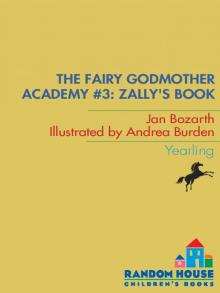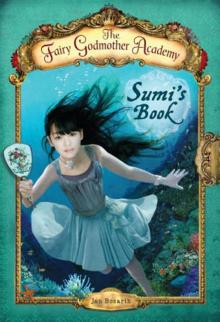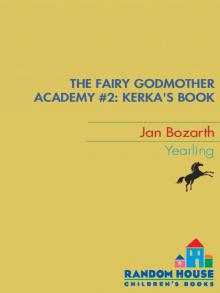- Home
- Jan Bozarth
Trinity's Book
Trinity's Book Read online
Praise for Kerka’s Book
“This sparkling combination of action and magic is bound to enchant.”
—Kirkus Reviews
“Excellent.… The writing is refreshingly well done and weaves together the author’s knowledge of art, folklore, and botany to paint a magical world where readers’ senses are piqued by the likes of stone fairies, cave anemones, and a queen named Patchouli.”
—SLJ
“Great for girls who love fairies and magical worlds.”
—KidzWorld.com
Praise for Birdie’s Book
“Bozarth’s tale is a beguiling mix of magic, adventure and eco-awareness, and her message of girl-power and positive change will resonate with tween readers.”
—Kirkus Reviews
“A fun, light read that ought to be a hit with girls who like adventure and magic.”
—Books for Kids (blog)
“Bozarth has taken the best aspects of various young adult genres and mixed them together in a fresh and optimistic way.”
—Kidsreads.com
The Fairy Godmother Academy
Birdie’s Book
Kerka’s Book
Zally’s Book
Lilu’s Book
Sumi’s Book
Trinity’s Book
This is a work of fiction. Names, characters, places, and incidents either are the product of the author’s imagination or are used fictitiously. Any resemblance to actual persons, living or dead, events, or locales is entirely coincidental.
Copyright © 2013 by FGA Media Inc.
All rights reserved. Published in the United States by Yearling, an imprint of Random House Children’s Books, a division of Random House, Inc., New York.
Yearling and the jumping horse design are registered trademarks of Random House, Inc.
“Learn to Fly” copyright © 2012 by Blue Arrow Music
Visit us on the Web!
randomhouse.com/kids
Educators and librarians, for a variety of teaching tools, visit us at RHTeachersLibrarians.com
Visit FairyGodmotherAcademy.com
Library of Congress Cataloging-in-Publication Data
Bozarth, Jan.
Trinity’s book / Jan Bozarth. — 1st ed.
p. cm. — (The Fairy Godmother Academy; bk. 6)
Summary: “Trinity travels to Aventurine and discovers her gift of flight.” —Provided by publisher.
eISBN: 978-0-375-89606-4
[1. Fairy godmothers—Fiction. 2. Fairies—Fiction. 3. Magic—Fiction. 4. Flight—Fiction. 5. Babies—Fiction. 6. Adventure and adventurers—Fiction.] I. Title.
PZ7.B6974Tri 2012 [Fic]—dc23 2012021268
Random House Children’s Books supports the First Amendment and celebrates the right to read.
v3.1
To all the girls and women taking
risks, growing, and moving toward
their dreams. “Learn to Fly” is
our anthem!
Cover
Other Books by This Author
Title Page
Copyright
Dedication
1. Kites
2. Tall Tales
3. Dream Walking
4. From Here to There
5. Friend or Foe
6. Fall or Fly
7. Moa
8. Cloud Travel
9. Born of Mist
10. The Great Cloud Getaway
11. Wings
12. Happy Birthdays
Acknowledgments
About the Author
It felt strange to be celebrating the Maori New Year on a beautiful spring day in New York City. In New Zealand, half a world away, my friends and family were also celebrating, but it was autumn.
I could imagine leaves falling from the trees in Auckland, and a chill in the morning air. But carrying my kite into Central Park, I could see that it was sparkling green with new growth, and the day was T-shirt warm. Only the breeze was just right.
“This looks like a good spot,” my father said. He set the picnic basket on the ground near a large sturdy oak and slipped off his kite bag.
I looked at the tree and smiled. Just begging to be climbed, I thought.
“Good on you, Henry Jones!” My mother’s bronze face glowed with the warmth of her smile. “It’s an excellent choice. There’s shade and lots of grass.”
“I’m so glad you approve, Marissa,” my father teased.
I laughed. “Dad, you’re such a hard case.”
“Watch the Kiwi, Trinity,” said my father with a wink.
Oops! I had to be careful about using my Kiwi—or New Zealand—expressions here in the States. “Hard case” meant an amusing person in New Zealand. In America, it meant someone who was rough and stubborn. Not my dad at all.
My Maori mother had called my American father by both his first and last names for as long as I could remember. He just called her Marissa. Sometimes he added, “The light of my life.” He had fallen in love with her fourteen years ago, when he first arrived in New Zealand to photograph the Matariki kites for a travel magazine. My mother had loved him at first sight, too. They married and had me a year later.
“Right here?” Dad asked, shaking out a large blanket.
Mom scanned the ground, squinting with a critical eye. “I don’t see any rocks,” she said. Then she grinned and grabbed two corners of the blanket to help lay it flat. “It’ll do just fine.”
“Thank the stars,” my father said, pretending to be greatly relieved. “I’m hungry!”
“We’ll eat as soon as everything is set out,” Mom said.
“Do you need help?” I asked.
“No, Trinity,” Dad answered. “Have a look around, but don’t go too far. We’ll call when we’re ready.”
I found a safe spot for my kite and rushed toward the huge oak. Quickly moving from one large branch to another, soon I was about twenty feet off the ground. From my vantage point in the tree, I could see the grassy field where we would fly our kites after lunch. Several kids were already there, flying kites they had bought in stores. Brightly colored paper and plastic diamonds, dragons, birds, and superheroes bobbed, dove, and fluttered against the clear blue sky. The little ones cried when they crashed or got caught in a tree.
That happened a lot. Although American kids seemed to share the Maori joy of kite flying, they sent their kites into the sky to soar or die on the whims of the wind. They had no control, and when their fragile birds broke, they threw away the pieces.
A Maori would never treat a kite in such a disrespectful manner. But of course, a Maori kite was not one of millions produced by machines. Each was unique, made by the hands that flew it, and most could be repaired. If not, it was either kept or buried and returned to the earth with reverence.
They aren’t toys, I thought.
Historically, Maori kites were much more than sources of amusement. Some were fashioned and flown in rituals. Others had been designed to carry warriors over the walls of enemy encampments. Huge kites built to cut through clouds were tethered with long ropes held by many men.
At least, that’s how it had been before the Europeans came in the 1800s. Aotearoa, the Maori word for “New Zealand,” had been quickly transformed. All the ancient kites were destroyed or lost, and the colorful expressions of our Maori culture were absent from our skies until manu tukutuku, the ancient art of kite craft, was brought back in the 1970s.
My mother taught me how to make a traditional tailless kite from grass, bark, and flax.
The love of flying it was in my Maori blood.
Unlike my ancestors, I did not believe that kites were mystical objects that connected heaven and earth, but sometimes I felt like I could fly. The feeling always hit me hard when I stood
a thousand feet in the air on the Sky Tower in Auckland. I even felt it now, a few feet off the ground in a tree.
Just spread your arms wide and let yourself go, the tree seemed to be telling me.
I came to my senses before I went splat on the ground. It was just a silly dream—childish. People could not fly.
“Come and get it!” Dad yelled.
I answered as I always do, “Get what?”
“Nothing if I eat it all first!” Dad joked with a booming laugh. Then, as he took a container of puff pastry squares out of the basket, he looked at Mom and faked a frown. “Next time we’re going to a park that lets people grill real picnic food.”
“Whatever you want, Henry Jones,” Mom said.
“I want hot dogs, hamburgers, potato salad, pickles, and chips.” He laughed again and kissed Mom on the cheek.
I wanted to go back to New Zealand. I missed the seaside city of Auckland. We had lived there until just after I turned twelve, almost a year ago. When my mother took a job as a commercial pilot based out of LaGuardia airport, we had to move to New York.
Dad was a freelance photographer who traveled on assignment. It didn’t matter if he flew out of Auckland or New York, so he didn’t mind where we lived.
I minded a lot! I didn’t want to leave my life and friends, especially Holly Jackson. We’ve been as close as sisters since we were three. At birth, she was named Hakeke, the Maori word for “mountain holly,” but I’ve always called her Holly. So does everyone else.
I sat cross-legged on the blanket and heaped a paper plate with Maori feast food. I loved beef wrapped in banana leaves, which Mom had found at a specialty food store. The aroma of spiced meat was tantalizing, even though it hadn’t been cooked in an umu, pits dug into the earth back in New Zealand. Mom had to use a slow cooker in our apartment kitchen. The tuna salad was tart and the bread melted in my mouth, but I did not take any of the traditional roasted sweet potatoes that most Maori loved. I hated kumara!
“Don’t eat too much, Trinity,” Dad warned. “You won’t be able to keep up with your kite.”
“My manu won’t get away from me,” I said.
“How many friends are coming to your slumber party tomorrow?” my mother asked.
“Three,” I said. “That’s all I invited.”
Life in the United States had gone from homesick to tolerable to practically glorious the instant I had enrolled in the Girls’ International School of Manhattan. There I met my new friends, Sumi, Zally, and Lilu.
“I still have to shop,” my mother muttered as she reached for a container of berries. “And I’ll need a list. Popcorn, fizzy drinks, cake …”
“Cake!” Dad stood up and pulled Mom away from the basket. “Let’s save dessert for later and go fly a kite!”
Mom looked at me sideways, and we both smiled. My dad was very much an artist. I’d inherited my mom’s love of numbers and logic, and our methodical, practical way of getting through life often mystified him.
But he understood our deep bond with the kites, and he embraced the art of manu tukutuku as though it were part of his own heritage. Taking pictures of kites had brought my mom and dad together.
We took the kites out of our bags and held them high off the ground as we headed to the field. Mine resembled a bird with a pointed head, an elongated tail, and stubby wings. In keeping with the old ways, our manu were decorated with natural fibers and dyes, feathers, shells, and flowers. I had cheated and used colored ribbons laced through the reeds to secure several seashells. The colors brightened the brown of the dry grasses, and my heart swelled with pride when I looked at it.
“When do you leave for Florida?” Mom asked. Dad had been hired by an entertainment magazine to do a photo layout of wildlife tourist attractions in Orlando.
“Two weeks,” he answered.
I fell back a step to let them talk in private. I had other things on my mind, mostly the awesome fact that I would turn thirteen tomorrow, and I was going to share my birthday with my closest friends.
All except Holly, who was eight thousand miles away.
I pulled my phone out of my pocket and sent her a text: Skype! 3:00 p.m. Sunday your time!
If I still lived in Auckland, it would already be my birthday.
But I wouldn’t know Sumi, Zally, and Lilu.
I grinned, thinking about my friends. We weren’t alike at all, and yet somehow we worked.
On my first day at the Girls’ International School of Manhattan, Zally gave me a giant chocolate chip cookie from her family’s bakery. Her infectious grin and bubbly good humor made me feel instantly welcome and at ease, and we quickly became friends. As a math lover, I could totally relate to the detailed precision of her fabulous maps. But I didn’t understand why she put so much thought and energy into charts of make-believe places.
I met Sumi and Lilu in algebra.
Sumi, an aspiring fashion designer who sees something beautiful in everything, and Lilu, an accomplished weaver who blushes at praise, were totally befuddled by that day’s lesson. I gave them some tips on how to solve the equations. Lilu gave me one of her friendship bracelets.
Sumi noticed my rough, calloused hands and told me they were a thousand times more beautiful than ones that never worked or made anything. I told her all about my passion for climbing rock walls, which is how I got the calluses.
“We should put some space between us and the other fliers,” Dad said. “Their puny little kites are seriously outmatched by our monster manu!”
“You’re not worried about some child’s kite, Henry Jones,” Mom said. “You just don’t want to be taking time to answer questions.”
“You’re right,” he said. “You answer them!”
I laughed as my father started running. His kite was airborne in seconds, slicing through the sky like a hawk tethered to his hand by twine.
A few seconds later, three boys showed up. Mom left to join Dad, leaving me to handle the questions. Someone always asked about our strange kites when we flew them.
“Is that a kite?” A redheaded boy with freckles pointed at my kite. “Where’d you get it?”
“It is a kite, and I made it,” I said.
“No, you didn’t,” a short boy with a buzz cut scoffed.
I held his gaze in chilly silence. It didn’t matter if he was being mean or showing off. He had called me a liar.
“I bet she did, Jordan,” the third boy said. He was cute with a mop of curly dark hair and brown eyes. “I saw pictures of kites like that in my geography book. From Australia, I think.”
“New Zealand,” I said.
“See,” Freckles teased in a snide voice. “You don’t know everything, Parker.”
“Never said I did,” Parker shot back.
“It won’t fly,” Jordan said.
I bit my tongue.
“Those two are flying.” Parker shielded his eyes from the sun and pointed at my parents’ kites.
Jordan shrugged. “Who cares about kites anyway? They’re not good for anything.”
“Maori warriors rode kites and swooped down on their enemies,” I said calmly. “With spears.”
“Awesome!” Parker exclaimed.
Jordan rolled his eyes.
“Get real!” Freckles laughed. “That kite couldn’t carry a chipmunk.”
I never have the patience to deal with boys who think they’re so smart and so cool that they can be totally obnoxious and nobody will care. I ran down the rise and launched my kite into the sky.
“Hey!” Parker shouted. “Do you come here a lot?”
I pretended I didn’t hear. Parker seemed like an okay guy. I hadn’t talked to him long enough to be sure. But I absolutely could not stand his friends.
I walked toward Mom and Dad, slowly letting the line out until my ribbon-feathered bird was almost as high as theirs.
“I hope you were nice,” Mom said.
“I wasn’t mean,” I said.
“That’s good,” my father said absent
ly. He winced when a gust caught his manu and pitched it to the side. The kite seemed doomed to fall, but he worked the twine, pulling it in and letting it out until the kite stabilized.
“That was close,” I said.
“Too close,” Dad agreed. “Still, I think I’m finally getting the hang of this. Want to see a loop-the-loop?”
“Like this?” Mom twisted and snapped her wrist. The flat grasses in her kite whistled and rattled as the triangle swooped through the air in a wide arc.
“Or this.” Dad yanked his line. Instead of zipping around in a tight circle, his kite shook and struggled to stay aloft.
“Here!” Mom handed me her line and grabbed Dad’s. An expert kite flier since she was a girl, my mother had an incredible sense of air currents and twine. She quickly brought the kite under control and gave it back to my father.
“Ta.” He used the New Zealand word for “thanks,” then smiled and kissed her. “No more fancy stuff today.”
Dad wasn’t a natural like my mother and me, but he didn’t usually have so much trouble. Then I realized that we had forgotten something vital.
“I know what’s wrong.” I began to chant the family’s turu manu, a kite charm that would make the kites fly better. Mom and Dad joined in.
The practice of singing as the kites ascended was as old as kites, and most Maori knew the ancient ritual chants that had been handed down through the generations. We always sang the lines my grandmother had composed for my mother years and years ago.
My bird is a beauty flier.
My bird is a golden hawk.
My bird reaches for the stars,
To fly beyond forever.
As we recited the words over and over, our three kites climbed steadily higher. Many modern Maori still believed that chanting had some mysterious mystical effect on kites, but that was just a silly superstition. The kites flew better because the repetition and cadence of chanting calmed and strengthened the people who were flying the kites.
I didn’t try to explain that anymore. My friends back in New Zealand didn’t care why it worked as long as it worked.

 Zally's Book
Zally's Book Sumi's Book
Sumi's Book Trinity's Book
Trinity's Book Kerka's Book
Kerka's Book